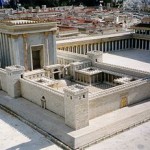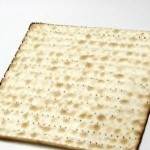 This story starts out with two blockbuster symbols: the temple, and Passover. Temples in the ancient world weren’t designed for worship, though that did take place there. They were built as a house for the deity, and, because of that, a place to perform all the cultic rituals for the deity. The temple was supposed to be an earthly representation of the god’s real house in heaven, and therefore it symbolized a link between the god and his people. Therefore the temple was looked on as the most sacred space there was on earth, and because of that it was the most important place in the human world.
This story starts out with two blockbuster symbols: the temple, and Passover. Temples in the ancient world weren’t designed for worship, though that did take place there. They were built as a house for the deity, and, because of that, a place to perform all the cultic rituals for the deity. The temple was supposed to be an earthly representation of the god’s real house in heaven, and therefore it symbolized a link between the god and his people. Therefore the temple was looked on as the most sacred space there was on earth, and because of that it was the most important place in the human world.
 The Passover was one of the most powerful remembrances of the Jewish community, commemorating the great power of God in setting them free from slavery. Passover symbolized judgment and salvation, life and prosperity. Putting these two powerful symbols side by side makes Jesus’ action overflowing with symbolic meaning.
The Passover was one of the most powerful remembrances of the Jewish community, commemorating the great power of God in setting them free from slavery. Passover symbolized judgment and salvation, life and prosperity. Putting these two powerful symbols side by side makes Jesus’ action overflowing with symbolic meaning.
In Jn. 2.13, as it was not yet Passover (the day), the crowd, including Jesus, would be in the city preparing for it. Traditionally a one-year-old unblemished male lamb would have to be chosen for the Passover meal by a member of the household. At this point Jesus is just entering the city, and the Temple mount, in all the hubbub before the actual event. In the temple courts he found men selling cattle, sheep, and doves, while others were exchanging money. All of this would be taking place in the Court of the Gentiles, within the Temple precinct, but not in the Temple proper. There was nothing wrong with the selling of animals, nor any problem with the money-changers in the neighborhood, but not there. The sacrifices required animals, and people could scarcely bring their offerings with them. They needed incense, oil, and the temple tax in a specific denomination of the approved currency. But they should not be doing it there. It was a holy place, not a market place. Fine if you have to sell your stuff, but keep this space sacred. Their spiritual indifference was the real problem.
Jesus, seeing the scene, made a whip and chased them all out. His action was not so much physical force as it was moral power. He was showing indignation at their presence and the desecration it symbolized. He knew they’d be back in just a short time, but his point was still important. “You’ve turned my Father’s house into a shopping plaza!” It’s the age-old problem of making everything into a commercial event. (Our Thanksgiving is now mostly an occasion for Black Friday; our Christmas is for retail sales; President’s Day and every other holiday is for special sales.) Jesus has come to reveal God to His people, and symbolically their only concern is how to make money off it all.
In a sense it was the same kind of problem as in 2 Samuel 6, where the ark of God had been in Abinidab’s house for so long that what was holy became commonplace, and the presence of God stopped being intimate communion and instead was more like “yeah, whatever.”
Here in John, just as in 2 Samuel 6, it was a lesson worth teaching. We need to be consumed by God’s being, to protect his holiness from desecration, and show reverence at all times when we are before him (see also Ex. 20.7: “Never misuse the name of the Lord”—don’t ever be careless around your God.) Jesus lived to make the truth about his Father known, and this was affront to God’s person.
The Jews who were there were intelligent people, and they recognized right away that what he had done had Messianic overtones and was an action of the coming Messiah (Ps. 69.9; Mal. 3.1-3), so they demanded more evidence of his grabbing at such Messianic symbols and authority. They understood that Jesus was, by his actions, challenging the entire sacrificial system. It’s interesting that they were not as much upset at what he did as they were at what he was claiming for himself as a status.
And now with great fascination we notice that Jesus’ response to their accusation of challenging the whole sacrificial system is a prophecy of his death and resurrection. Whoa! Sort of like, “What are you doing with our sacrificial system?” And Jesus replied, “I will die and rise again.” The temple was a symbol of God’s presence on earth, the Passover was a remembrance of judgment and salvation, the accusation is that Jesus has made himself the Messiah sent from God, and Jesus’ answers to all of it are (1) God’s holiness must be kept sacred, and (2) Since I am God’s presence on earth, I will die and rise again and replace the entire sacrificial system. I am the true Temple of God from heaven of which this building is only a shadow.
So who is on the witness stand giving testimony that Jesus is God? This time it’s Jesus himself.